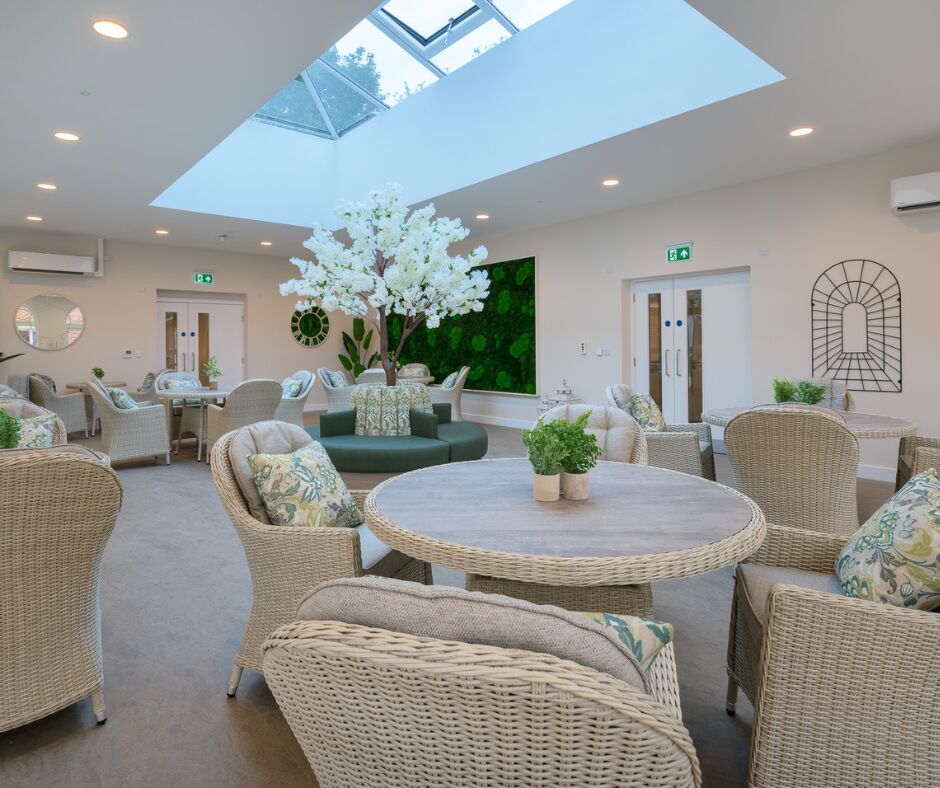Choosing a care home is one of the most important decisions you will make for your loved one. To help make the decision process easier, we’ve brought in advice from care home managers across the St Mary’s Care Group to put together 10 essential top tips when viewing a care home. This checklist will help guide you through your show round, outlining the benefits of asking specific questions to help inform your decision on a care home for your loved one.
1) Use Your Senses
First impressions count for a lot so trusting your senses will give you a solid foundation on deciding if a home is right for your loved one. Does the home look clean and well maintained? Is it fresh-smelling throughout bedrooms, lounges, and corridors? How loud is the home? What is your gut feeling as you walk through the home?
By using your senses, you’ll have a base to work from on whether you want to invest more time into getting to learn more about the home and the specifics about the care and facilities on offer.
If a home looks and smells good, and has a calming atmosphere, you’ll have confidence that this is a clean and pleasant environment, providing a comfortable and dignified place for your loved one to live in.
2) Staff Friendliness and Interaction
Kind, caring staff create a positive atmosphere where residents feel valued, safe, and part of a family rather than just being ‘looked after’.
Whilst viewing a care home, observe how staff speak to residents. Do they greet residents by name? Are they warm, respectful, and patient? By viewing these interactions, you can get an idea for the general culture within the home and how residents are treated on a daily basis.
To help get an even clearer idea on staff interactions with residents, you can also ask questions about how staff get to know residents personally. What steps do they take to fully understand the resident’s care needs, their life experiences, cultural/religious beliefs as well as hobbies and interests.
By meeting different staff members, whether that is the activities coordinator or chef, you can give yourself the opportunity to ask more questions and get a more rounded picture on the staff that your loved one will interact with on a daily basis.
3) Resident Wellbeing
One piece of advice which is often overlooked when visiting a care home is actually meeting and talking with residents. Seeing residents happy and well cared tells you that staff are attentive to individual needs and emotional wellbeing, not just physical care.
Talking to residents can provide fantastic insights into daily life at a home. Ask them about their thoughts about their rooms and whether they can personalise them. Get their opinions on the facilities on offer, the events/activities that they take part in and how often those take place. Also ask questions about what life looks like on a normal day and whether they are able to choose their daily routines (when they get up, have meals out etc.).
4) Activities and Social Life
A good activity programme helps residents maintain independence, mental stimulation, and friendships, which prevents loneliness and improves quality of life. Whilst viewing a care home, check out their activity boards or request a copy of their schedules.
Speak to their activities coordinator to get an idea of how they put activities together. Are the activities designed to help with individual needs? How often do they host group activities, events or trips out? What do they do to get to know residents to help them pursue hobbies or interests?
By asking these types of questions, you can get a feel for how engaged residents are and how the home supports them to live a more active lifestyle.
5. Personalised Care and Care Services
A key decider when choosing a care home is looking at whether the care on offer is suitable for the prospective resident. If a loved one has advanced dementia or complex care needs, you want to know that the home in question has the staff and facilities in place to provide the best quality of care for the individual.
It is also important to think not just about the care that can be provided now, but in the future. Care homes need to have flexibility to cater for residential and complex care, so if the care needs of a resident change, they don’t need to move to a different care home.
Personalised care is another important area to ask questions about. You want to ensure your loved one is treated as an individual, maintaining dignity, choice, and familiarity in their daily life. To assess the type of care a home would provide for your loved one, ask how care plans are created and updated. Are residents and families involved? How do staff get to know personal routines and preferences?
Through these steps, you’ll paint a picture on how the home will support you and your loved one to ensure care is tailored to their needs for now and the future.
6) Meal Quality and Dining Experience
Meal times are a cornerstone of any care home environment. Enjoyable, balanced meals keep residents healthy, encourage good nutrition, and make mealtimes a sociable, enjoyable part of the day. When viewing a care home, make sure you look at menus and observe mealtimes if possible. Are meals nutritious, appealing, and adaptable to dietary needs? How often are the menus changed and do residents have a choice on when and what they want to eat?
Another point to consider is what residents have access to outside of meal times. What is the process to assess if residents can make food or drinks for themselves? Do residents have access to snacks whenever they want or are they available at certain times? These prompts are designed to get a better picture around resident independence and what they are able to do for themselves.
Meals are social occasions so it is also worth asking about whether visitors can join during meal times. To give residents a change of scenery, you also may want to find out what are the policies are around taking residents out for dinner or if the homes take groups of residents out to restaurants/pubs.
7) Room Comfort, Privacy and Safety
A main feature of any show round of a care home is to visit the bedrooms. These are spaces that need to be comfortable and homely, providing privacy and dignity to make the resident feel truly ‘at home’ rather than in an institution.
As part of the ‘sensory approach’ to show rounds, bedrooms are often the room where you get the strongest view on whether it is the right environment for your loved one. You’ll need to check for cleanliness, the temperature of the room, and see if there is scope to add personalised touches with furniture, photos, ornaments, or belongings.
When it comes to care, take a look to see if the room is accessible. Does it have an ensuite with handrails and other mobility aids or are there assisted bathrooms on the floor where the room is situated? Are the profiling beds manual or electric? Is there an emergency pull-cord available and easy to locate? These small details play their part in giving you peace of mind that your loved one is safe and has the right facilities available for their needs.
Other things to bear in mind include how accommodating the home is, especially to personal requests. This can range from allowing pets to stay in the resident’s bedroom to larger suites for couples or family members to stay over.
8) Multiple Visits
Visiting care homes for a show round can be tricky. You’ll have a long list of questions for every home you visit, trying to get as much information as possible. During this process, if a care home in particular ticks a lot of boxes, we always recommend you arrange a couple of visits to see the home at different times of the day.
The purpose of this is so you can see how the home operates at different times of the day, whether that’s meal times, activities or just to see how different sets of staff engage with residents. By visiting a care home at different times during the day, you’ll get a better picture of what a day in the home looks like and a better opportunity to spend time with different staff members and existing residents.
9) Feedback and Reviews
Before going to visit any care home, it is worth checking out reviews and feedback about the home you plan to see. Read recent CQC or inspection reports to get a clear idea of the standard care provided, and online reviews to get resident and resident family perspectives.
There are a number of portals available that help show recent reviews on care homes. We would recommend looking at Carehome.co.uk, Autumna and Lottie. Each of these portals allow you to see honest and verified feedback, highlighting how homes maintain standards and handles any issues, helping you choose a care home with confidence.
Alternatively, you can also ask the care home manager for testimonials from current families.
10) Family Involvement
Choosing to put a loved one into a care home is stressful and complicated. That’s why it is crucial to get an understanding of how a home supports you and your family through the process of putting together a care plan, fee contracts and visits for your loved one.
View this as a partnership with the home, working together to support your loved one’s wellbeing. From the very beginning, ask how a care home puts a care plan together to assess how you, your family and loved one can be involved to ensure it is as personalised as possible. Ask how families can stay involved in care planning so if anything changes with your loved one’s health requirements, you are consulted about the next steps to meet those needs.
Regarding fees and contracts, there are a couple of key questions to ask. Before discussing permanent stays, ask if the home offers day care or respite services so your loved one can get a feel for the environment over a short period to see whether it is a good fit for them. For residency, get clear answers on what the monthly fees are, what they include and whether fees are paid in advance or arrears. Find out what the procedure is around fee increases and how much notice is given to residents and their families.
Around the subject of visiting, it is good to get a clear understanding from the home manager of when families are able to visit, what visitors need to be mindful of when at the home and protocols around taking residents out for trips and outings.
Final Thoughts
Using this guide, it will give you a base to work with as to what to look for and what’s important to your loved one and family. For any homes you visit, we recommend bringing a checklist, where you can note down your impressions, and trust your instincts.
The right care home will not only meet your loved one’s practical needs but help them thrive in a warm and caring environment.
If you are searching for more information on questions to ask when visiting a care home, take a look at Carehome.co.uk’s guide.






